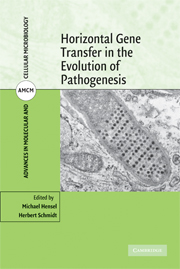Book contents
- Frontmatter
- Contents
- Preface
- Contributors
- PART I Theoretical Considerations on the Evolution of Bacterial Pathogens
- 1 Genomes in Motion: Gene Transfer as a Catalyst for Genome Change
- 2 Bacterial Recombination in vivo
- PART II Mobile Genetic Elements in Bacterial Evolution
- PART III Paradigms of Bacterial Evolution
- PART IV Interkingdom Transfer and Endosymbiosis
- Index
- References
2 - Bacterial Recombination in vivo
from PART I - Theoretical Considerations on the Evolution of Bacterial Pathogens
Published online by Cambridge University Press: 16 September 2009
- Frontmatter
- Contents
- Preface
- Contributors
- PART I Theoretical Considerations on the Evolution of Bacterial Pathogens
- 1 Genomes in Motion: Gene Transfer as a Catalyst for Genome Change
- 2 Bacterial Recombination in vivo
- PART II Mobile Genetic Elements in Bacterial Evolution
- PART III Paradigms of Bacterial Evolution
- PART IV Interkingdom Transfer and Endosymbiosis
- Index
- References
Summary
INTRODUCTION
In eukaryotes, the great majority of genetic recombination takes place during the complex and highly organized process of meiotic division, a part of sexual reproduction. As a consequence there are a number of constraints on patterns of variability in the recombination process. Recombination takes place only between organisms that are similar enough for their offspring to be viable, and therefore it is generally limited in the novelty it can introduce. Within species, the most common cause of reproductive isolation is geographical separation. In most higher animals and plants, the number of crossovers per chromosome is predictably a number between 1 and 5 in both sexes. Even where individuals differ in the amount of recombination that they initiate, for example because of the absence of crossing over in male Drosophila, the existence of a common mating pool will tend to homogenize the population with respect to the amount of genetic exchange that has occurred in the ancestry of each individual. In summary, while the mating process is elegant, eukaryotic recombination is typically quite predictable with minimal differences in genetic patterns between individuals in the same species.
In bacteria, there are no such rules. Recombination is never obligate and occurs by three distinct mechanisms; transformation, transduction, and conjugation, each of which in their nature can vary enormously between lineages.
- Type
- Chapter
- Information
- Publisher: Cambridge University PressPrint publication year: 2008

